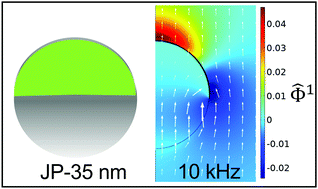Electric polarizability of metallodielectric Janus particles in electrolyte solutions†
Abstract
Metallodielectric Janus particles (JPs) and electric fields have been a useful combination for the development of innovative concepts on AC electrokinetics, directed transport and collective dynamics. The polarizability, and its frequency dependence, underlie the rich behavior exhibited by JPs. Nonetheless, direct measurements of polarizability are few and the interplay of different mechanisms remains unclear. This paper discusses measurements and strategies to tailor the magnitude of the polarizability of JPs. Our approach uses electrorotation to measure the polarizability of particles with different thicknesses of metal in electrolyte solutions. On the other hand, we gain further insight into the basic polarization mechanisms through modeling based on the fundamental transport equations. JPs exhibit rich polarization spectra that depend strongly on the thickness of the metal layer, the conductivity of the medium and the surface charge. At low frequencies—around 10 kHz—the results indicate that counter-field rotation stems from the charging of the double layer at the particle–electrolyte interface, while the transition to co-field rotation at high frequencies (above 100 kHz) stems from the Maxwell–Wagner relaxation. The latter polarization mechanism is significantly affected by the conductivity within the electrical double layer. The insights from this study provide helpful quantitative information for the design of colloidal machines with desirable features such as targeted propulsion, and tunable collective dynamics.



 Please wait while we load your content...
Please wait while we load your content...